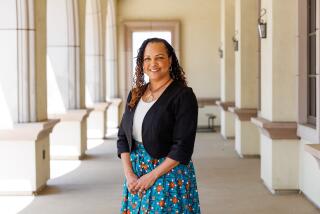Mainstreaming Can Hold Everybody Back : Consider all children--able as well as mentally and physically disabled--before changing school policy.
- Share via
Can developmentally disabled children learn more in a mainstream classroom than they would in a special class?
Thirty-five years ago, most mentally and physically handicapped children were excluded from any form of education in public schools. Today the pendulum has swung in the opposite direction as a class-action suit pressures the Los Angeles Unified School District to place more disabled students in mainstream classes rather than separate special education programs.
Educators have spent years developing specialized methods for teaching retarded children to read and write at a pace appropriate to ability. Now all that effort may go to waste.
The new term, “inclusion,” sounds democratic and forward-thinking. But does it really address the needs of the children? Administrators, lawyers and parents can dream of a perfect world where all disabled children are accepted by their peers in mainstream classes. But policies are too often based on generalizations developed by professionals who are out of touch with the reality of the classroom.
Is a severely disabled child in a wheelchair “included” in a regular classroom setting if he or she has to spend the day at the back of the room near the exit, ignored by a busy teacher trying to cope with 29 able, active students? What do regular students, already struggling with their own learning, gain from the presence of an emotionally disturbed or mentally retarded student who has a fit, throws a tantrum or attacks a classmate?
The concept of inclusion is deceptive because it helps parents believe that their child is being normalized. It takes away the stigma of “special education,” “disabled” or “retarded.” It makes administrators feel good because they are integrating all students into one common program. In reality, inclusion is creating a nightmare for teachers and is harming both regular and special students.
When our Down’s syndrome son was born 37 years ago, the doctor suggested that he be placed in an institution. We ignored this advice and brought up Andrew as an integral part of our family. Andrew benefited from the individual attention of trained teachers in special education classes in the Chicago public schools. A partial mainstreaming program in high school helped his social adjustment and taught other students to accept him. Placement in special or regular classes should be adjusted according to a student’s progress. If, in his early formative years, Andrew had been included in a regular elementary classroom, he would have foundered as he struggled to learn. Failure would have destroyed his self-esteem and he would have become a target for teasing.
As a result of his educational experience and home life, Andrew acquired confidence and the skills to function in the working world. He now lives in a community for the handicapped where he enjoys an active social life under the umbrella of a well-run residential program. For the last 12 years, he has worked full-time at a supermarket. He is known for his conscientiousness and outstanding punctuality. Customers ask for him because he packs their groceries so carefully.
Instead of working with disabled children in a separate program, special education teachers coping with “inclusion” are left to worry about their students reaching high school without being able to write a simple sentence or count money because an aide did their homework for them. It is important to teach these children the basic skills of living. For some, a work study program will enable them to find jobs and live independently.
Special education encompasses a wide range of disabilities, from high-functioning children who can benefit from being included in a regular classroom setting to the severely disabled who need one-on-one training in a separate program. Who will gain from the integration of all children, regardless of physical or mental ability? Will the administrators be praised for their all-embracing policy? Will the school system save money? Will the parents feel less guilty? Will able children be more understanding? Will the high-functioning disabled child be better educated and better adjusted? Will the severely disabled child have his needs met?
There are too many variables. All children will suffer if the pressure for inclusion eliminates valuable special education programs. Disabled students should have their needs assessed individually and be placed in settings that will provide them with the best training for life.






